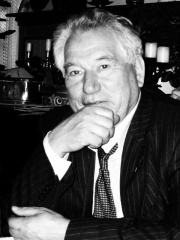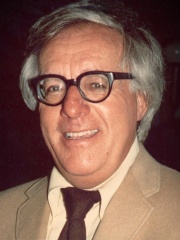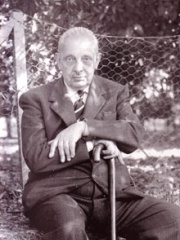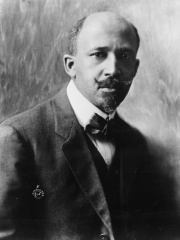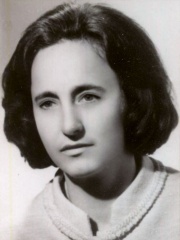WRITER
Tristan Tzara
1896 - 1963

 Tristan Tzara
Tristan Tzara
Tristan Tzara (; French: [tʁistɑ̃ dzaʁa]; Romanian: [trisˈtan ˈt͡sara]; born Samuel or Samy Rosenstock, also known as S. Samyro; 28 April [O.S. 16 April] 1896 – 25 December 1963) was a Romanian and French avant-garde poet, essayist and performance artist. Also active as a journalist, playwright, literary and art critic, composer and film director, he was known best for being one of the founders and central figures of the anti-establishment Dada movement. Under the influence of Adrian Maniu, the adolescent Tzara became interested in Symbolism and co-founded the magazine Simbolul with Ion Vinea (with whom he also wrote experimental poetry) and painter Marcel Janco. During World War I, after briefly collaborating on Vinea's Chemarea, he joined Janco in Switzerland. Read more on Wikipedia
His biography is available in 67 different languages on Wikipedia (up from 66 in 2024). Tristan Tzara is the 227th most popular writer (down from 205th in 2024), the 11th most popular biography from Romania and the 2nd most popular Romanian Writer.
Tristan Tzara is most famous for his Dadaist poems and his co-founding of the Dadaist movement.
Memorability Metrics
Page views of Tristan Tzara by language
Among WRITERS
Among writers, Tristan Tzara ranks 227 out of 7,302. Before him are Chinghiz Aitmatov, Lu Xun, Stanisław Lem, Anacreon, Annie Ernaux, and Gotthold Ephraim Lessing. After him are Isaac Bashevis Singer, John the Evangelist, Pliny the Younger, Nelly Sachs, Ray Bradbury, and Pedro Calderón de la Barca.
Most Popular Writers in Wikipedia
Go to all RankingsChinghiz Aitmatov
1928 - 2008
HPI: 77.57
Rank: 221
Lu Xun
1881 - 1936
HPI: 77.56
Rank: 222
Stanisław Lem
1921 - 2006
HPI: 77.56
Rank: 223
Anacreon
570 BC - 485 BC
HPI: 77.55
Rank: 224
Annie Ernaux
1940 - Present
HPI: 77.55
Rank: 225
Gotthold Ephraim Lessing
1729 - 1781
HPI: 77.54
Rank: 226
Tristan Tzara
1896 - 1963
HPI: 77.53
Rank: 227
Isaac Bashevis Singer
1902 - 1991
HPI: 77.49
Rank: 228
John the Evangelist
10 - 100
HPI: 77.45
Rank: 229
Pliny the Younger
61 - 113
HPI: 77.45
Rank: 230
Nelly Sachs
1891 - 1970
HPI: 77.39
Rank: 231
Ray Bradbury
1920 - 2012
HPI: 77.38
Rank: 232
Pedro Calderón de la Barca
1600 - 1681
HPI: 77.37
Rank: 233
Contemporaries
Among people born in 1896, Tristan Tzara ranks 9. Before him are Jean Piaget, Georgy Zhukov, Lev Vygotsky, André Breton, Imre Nagy, and A. C. Bhaktivedanta Swami Prabhupada. After him are Roman Jakobson, Antonin Artaud, Gerty Cori, Giuseppe Tomasi di Lampedusa, Konstantin Rokossovsky, and Robert S. Mulliken. Among people deceased in 1963, Tristan Tzara ranks 10. Before him are Robert Frost, Jean Cocteau, Georges Braque, Aldous Huxley, Robert Schuman, and W. E. B. Du Bois. After him are Lee Harvey Oswald, C. S. Lewis, Ngo Dinh Diem, Thích Quảng Đức, Francis Poulenc, and Abd el-Krim.
Others Born in 1896
Go to all RankingsJean Piaget
PSYCHOLOGIST
1896 - 1980
HPI: 82.27
Rank: 3
Georgy Zhukov
POLITICIAN
1896 - 1974
HPI: 80.82
Rank: 4
Lev Vygotsky
PSYCHOLOGIST
1896 - 1934
HPI: 80.34
Rank: 5
André Breton
WRITER
1896 - 1966
HPI: 79.00
Rank: 6
Imre Nagy
POLITICIAN
1896 - 1958
HPI: 77.93
Rank: 7
A. C. Bhaktivedanta Swami Prabhupada
RELIGIOUS FIGURE
1896 - 1977
HPI: 77.86
Rank: 8
Tristan Tzara
WRITER
1896 - 1963
HPI: 77.53
Rank: 9
Roman Jakobson
LINGUIST
1896 - 1982
HPI: 76.47
Rank: 10
Antonin Artaud
WRITER
1896 - 1948
HPI: 75.38
Rank: 11
Gerty Cori
CHEMIST
1896 - 1957
HPI: 75.23
Rank: 12
Giuseppe Tomasi di Lampedusa
WRITER
1896 - 1957
HPI: 74.75
Rank: 13
Konstantin Rokossovsky
MILITARY PERSONNEL
1896 - 1968
HPI: 74.73
Rank: 14
Robert S. Mulliken
CHEMIST
1896 - 1986
HPI: 74.46
Rank: 15
Others Deceased in 1963
Go to all RankingsRobert Frost
WRITER
1874 - 1963
HPI: 83.18
Rank: 4
Jean Cocteau
WRITER
1889 - 1963
HPI: 80.33
Rank: 5
Georges Braque
PAINTER
1882 - 1963
HPI: 79.91
Rank: 6
Aldous Huxley
WRITER
1894 - 1963
HPI: 78.24
Rank: 7
Robert Schuman
POLITICIAN
1886 - 1963
HPI: 77.93
Rank: 8
W. E. B. Du Bois
SOCIAL ACTIVIST
1868 - 1963
HPI: 77.66
Rank: 9
Tristan Tzara
WRITER
1896 - 1963
HPI: 77.53
Rank: 10
Lee Harvey Oswald
EXTREMIST
1939 - 1963
HPI: 76.93
Rank: 11
C. S. Lewis
WRITER
1898 - 1963
HPI: 76.86
Rank: 12
Ngo Dinh Diem
POLITICIAN
1901 - 1963
HPI: 76.40
Rank: 13
Thích Quảng Đức
SOCIAL ACTIVIST
1897 - 1963
HPI: 75.84
Rank: 14
Francis Poulenc
COMPOSER
1899 - 1963
HPI: 74.73
Rank: 15
Abd el-Krim
POLITICIAN
1882 - 1963
HPI: 74.67
Rank: 16
In Romania
Among people born in Romania, Tristan Tzara ranks 11 out of 844. Before him are Eugène Ionesco (1909), Michael I of Romania (1921), Stephen Báthory (1533), Alaric I (376), Emil Cioran (1911), and John Hunyadi (1407). After him are Ion Antonescu (1882), Béla IV of Hungary (1206), Herta Müller (1953), Mircea Eliade (1907), Elena Ceaușescu (1916), and Radu cel Frumos (1438).
Others born in Romania
Go to all RankingsEugène Ionesco
WRITER
1909 - 1994
HPI: 79.45
Rank: 5
Michael I of Romania
POLITICIAN
1921 - 2017
HPI: 79.19
Rank: 6
Stephen Báthory
POLITICIAN
1533 - 1586
HPI: 78.70
Rank: 7
Alaric I
POLITICIAN
376 - 410
HPI: 78.28
Rank: 8
Emil Cioran
PHILOSOPHER
1911 - 1995
HPI: 78.22
Rank: 9
John Hunyadi
POLITICIAN
1407 - 1456
HPI: 77.72
Rank: 10
Tristan Tzara
WRITER
1896 - 1963
HPI: 77.53
Rank: 11
Ion Antonescu
POLITICIAN
1882 - 1946
HPI: 77.28
Rank: 12
Béla IV of Hungary
POLITICIAN
1206 - 1270
HPI: 77.28
Rank: 13
Herta Müller
WRITER
1953 - Present
HPI: 76.59
Rank: 14
Mircea Eliade
HISTORIAN
1907 - 1986
HPI: 76.17
Rank: 15
Elena Ceaușescu
POLITICIAN
1916 - 1989
HPI: 76.06
Rank: 16
Radu cel Frumos
POLITICIAN
1438 - 1475
HPI: 76.00
Rank: 17
Among WRITERS In Romania
Among writers born in Romania, Tristan Tzara ranks 2. Before him are Eugène Ionesco (1909). After him are Herta Müller (1953), Paul Celan (1920), Elie Wiesel (1928), Dimitrie Cantemir (1673), Jacob L. Moreno (1889), Mihai Eminescu (1850), Panait Istrati (1884), Dositej Obradović (1742), Károly Kerényi (1897), and Ion Luca Caragiale (1852).
Eugène Ionesco
1909 - 1994
HPI: 79.45
Rank: 1
Tristan Tzara
1896 - 1963
HPI: 77.53
Rank: 2
Herta Müller
1953 - Present
HPI: 76.59
Rank: 3
Paul Celan
1920 - 1970
HPI: 75.26
Rank: 4
Elie Wiesel
1928 - 2016
HPI: 72.03
Rank: 5
Dimitrie Cantemir
1673 - 1723
HPI: 71.85
Rank: 6
Jacob L. Moreno
1889 - 1974
HPI: 71.09
Rank: 7
Mihai Eminescu
1850 - 1889
HPI: 70.52
Rank: 8
Panait Istrati
1884 - 1935
HPI: 68.42
Rank: 9
Dositej Obradović
1742 - 1811
HPI: 66.43
Rank: 10
Károly Kerényi
1897 - 1973
HPI: 65.15
Rank: 11
Ion Luca Caragiale
1852 - 1912
HPI: 63.94
Rank: 12
